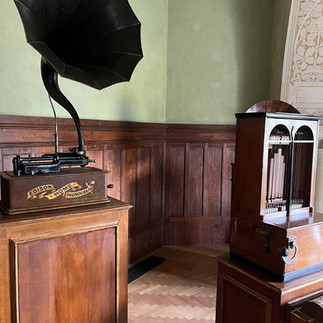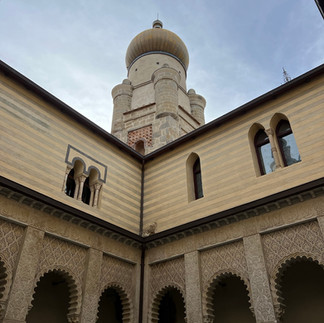Visiting the Rocchetta Mattei, the exotic castle in the Bolognese hills
- Vanessa Valenti

- Oct 24, 2023
- 7 min read
Among the splendid hills of Grizzana Morandi, on the Tuscan-Emilian Apennines, we can find the enchanting Rocchetta Mattei, a castle of rare beauty with an exotic charm that allows you to travel between the splendid arabesque palaces that characterize Seville and Granada, up to the wonderful Moroccan Madrasas.

The Rocchetta Mattei is a castle that owes its name to Count Cesare Mattei (1809-1896) who had it built on the ruins of the Rocca di Savignano, dating back to the 13th century. The structure of the Rocchetta has been modified several times, giving life to an incredible labyrinth of towers, stairways and exotic rooms that blend various architectural styles: from neo-medieval to neo-Renaissance, from Moorish to Liberty. But let's find out something more about the first owner of the Rocchetta, Cesare Mattei, whose life and history are inextricably linked to that of the castle. Cesare Mattei was born in Bologna at the beginning of the 19th century to a wealthy family and in 1837 he was one of the 100 founders of the Cassa di Risparmio in Bologna and in 1847 he received the title of Count from Pope Pius IX. His life changed drastically with the death of his mother in 1844, the last push to leave Bologna also due to his disappointing political experience. The Count then retired to study his "new medicine": Electromyopathy and in 1850 he purchased the land where the ruins of the medieval castle of the Rocca di Savignano stood and undertook the construction of the "Rocchetta", personally directing the works.

Count Mattei moved permanently to Rocchetta in 1859, leading the life of a medieval lord complete with court, parties and banquets. Here, he dedicated himself mainly to the study and dissemination of alternative medicine which he called Electrohomeopathy, which brought him worldwide fame (among his patients there were famous people such as Tsar Alexander II and Ludwig III of Bavaria) and creating a real market exporting his homeopathic preparations even abroad. To give you an idea of the fame that the Count gained, both the Rocchetta Mattei and the figure of the Count are cited in many novels such as the famous "The Brothers Karamazov" by Dostoevskji, in which a passage is reported in which the Devil tells of having turned to Cesare Mattei's Electrohomeopathy to cure his severe discomfort. In these years, the territories around the Rocchetta lived a prosperous period, characterized by development and prosperity: many families in the area found work and the Count also contributed to the construction of the railway station which allowed him to bring his patients to court.

7 years after his death, the remains of Cesare Mattei, according to the wishes of his will, were brought back to the castle and now lie inside the monumental tomb in the Rocchetta chapel. Since the death of the count, the history of the Rocchetta became stormy, until it was finally abandoned in the 1980s and was then purchased in 2005 by the Cassa di Risparmio di Bologna Foundation (Carisbo). In recent years, the recovery and restoration work on the building began, which made it possible to re-establish its artistic and cultural value and make it accessible again in 2015, after years of closure and abandonment. The management of the Rocchetta is in charge of the Municipality of Grizzana Morandi and at the moment only half of the castle can be visited: the entire part of the Count's private apartments will probably be renovated in the coming years and therefore, hopefully, once they will be accessible and visitable. At the moment, inside the visitable part of the castle, there is a spectacular exhibition of historical and contemporary musical instruments of Count Mattei: this collection, on loan to the Rocchetta, serves to immerse visitors in the Count's era and let them touch more concretely what life could have been like in the castle halls.
I must admit that hearing these 150-year-old musical instruments being played was a goosebumps experience: the perfect icing on the cake on a visit that we had already enjoyed incredibly. Certainly, thanks also to the precise and very interesting guided tour, we fully enjoyed our experience in Rocchetta between the charm of its extravagant founder and the magnificence of the environments that took us back to our travels in Andalusia and Morocco, Rocchetta Mattei for us is it was a big yes!

How to get to Rocchetta Mattei
The Rocchetta Mattei is located within the municipality of Grizzana Morandi, about 50 km from Bologna, and can therefore be reached from here in about 1 hour by car. The Castle does not have parking spaces reserved for visitors but it is possible to leave the car for free on the roadside, but Rocchetta Mattei is also easily reachable using public transport as it is well connected! The Castle is in fact located 1.5 km from the Riola railway station, served daily by multiple regional trains from Bologna and other Italian cities. Once you arrive in Riola, you can take a bus to reach Rocchetta (Line 963 leaves from Riola and has a stop dedicated to Rocchetta), or opt for a short 20-minute walk.
Visiting the Rocchetta Mattei

The visit to Rocchetta Mattei is permitted only if accompanied by a guide, which is included in the ticket price. Usually, there are small groups (20 people) who are led to discover the wonders of the castle escorted by a highly trained guide for a visit lasting a total of just over an hour. Booking is mandatory: it is not possible to show up in Rocchetta and hope to get a ticket to visit it, as booking allows the formation of these groups and the organization of guides. I suggest you book a little in advance because many dates are often sold out, especially in the winter period when opening hours are reduced. To evaluate availability and therefore book your visit to Rocchetta, I refer you directly to the official website - Booking a tour in the Rocchetta Mattei

The cost of the visit is €10 each and, as mentioned before, also includes a guide who will accompany you throughout the entire journey. Opening hours: - Saturday, Sunday and public holidays except December 25th and January 1st from 9.30am to 5.30pm; - From November 1st to March 31st from 10:00 to 15:00. It is recommended to arrive in Rocchetta 15 minutes before the start of the visit in order to organize the small group for the visit! P.s: the entry of animals is prohibited!
What to see inside the Rocchetta Mattei
As mentioned before, at the moment only half of the castle can be visited, which corresponds to the most public part of the Rocchetta; in particular, you will get to see:
the Room of the Nineties: in this room, the Count would have liked to celebrate his ninetieth birthday together with 90 other ninety-year-olds, which is why the room was called "of the Nineties", but this never happened. In fact, the Count died at the age of 87;

the Music Room: with Art Nouveau furnishings and decorations, it was the place where Mattei hosted nobles from noble families from all over Europe and listened to music;
the Red Room: used by the Count as a personal study, it takes its name from the color of the curtains that once decorated the room;
the Chapel: certainly the most evocative space of the entire castle, where arches and columns intertwine with each other giving life to real optical illusions, with geometric patterns and colors inspired by the Islamic world, in particular by the Great Mosque of Cordoba;
the Tomb of Count Cesare Mattei: located on the upper floor of the chapel, it was built after Mattei's death, following his wishes exactly as indicated in his will. It is a room full of symbols, with references to the grandeur of the universe that clashes with human finiteness;
the Courtyard of the Lions: a splendid internal courtyard with clear decorative references to Arab-style buildings such as the Alhambra in Granada. Splendid arches, Arabic inscriptions, azulejos and a wonderful central fountain: everything in this courtyard recalls the Arab world even if the inscriptions that should report the verses of the Koran are wrong!
What to do near the Rocchetta Mattei

Rocchetta Mattei is located on the top of a 400-meter-high relief from which, with the mountains of the northern Apennines as a backdrop, it is possible to enjoy one of the most beautiful views of the Bolognese Hills. Once you have visited the Rocchetta, don't stop and keep on discovering this wonderful corner of the world and explore these hills... there are so many things to do and visit! Let me give you some ideas and inspiration on what to combine with a visit to Rocchetta Mattei:
lunch in one of the typical farmhouses or taverns in the area to taste the typical dishes of the Bolognese tradition but also recipes based on local and seasonal products, such as mushrooms and truffles;
visit Borgo "La Scola", a beautiful village among the most characteristic in the area: as soon as you arrive here you will feel like you have gone back in time to the Middle Ages. Most of the buildings, in fact, date back to a period around 1400 and 1500 and therefore represent an incredible testimony to the medieval architecture of the Apennines, given that they have been preserved almost entirely. Borgo “La Scola” is actually a fortified village and therefore born as a military district and place of resistance and defense of the Montovolo Monastery, which had great economic and commercial as well as religious importance. In fact, the famous wars between the Franks and the Lombards took place in this area. The village had a strategic role and a military function which is expressed in the buildings and towers which served a defensive role;
visit the Labante Caves: located in the municipality of Laiano, they are an excellent destination to discover the surroundings of Rocchetta Mattei: in just over half an hour's drive (about 20km) you will have reached them. 54 meters long and with a difference in height of approximately 15 meters, the Travertino di Labante caves are among the largest in Italy of this material. Inside them, the rock is hollow and gives life to a unique karst phenomenon. The Caves were formed thanks to the river coming from the San Cristoforo spring, which forms a small waterfall here. The first studies on the caves date back to the 17th and 18th centuries and archaeological finds dating back to the 1300s and 19th centuries have been found in the area; in fact, it seems that the caves were frequented by the Etruscans of Marzabotto, who used the site as a travertine quarry for the construction of artifacts, sacred statues and funerary monuments. The visit to the caves lasts half an hour or so.
have a nice hike inside the Corno alle Scale Regional Park: Corno alle Scale is a mountain in the Tuscan-Emilian Apennines whose name derives from the particular shape of the northern face, made up of a series of stepped rocky crags. Within the Corno area, there are many trekking paths and one- or half-day routes that are perfect after a visit to Rochetta Mattei, especially in autumn, when the foliage dyes the landscape red and orange.

So, what do you think of Rocchetta Mattei? Will you go there? Let me know and don't hesitate to contact me for any information!













Comments